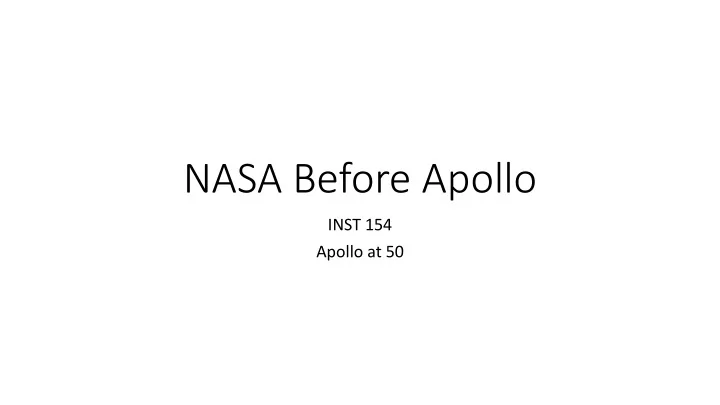

NASA Before Apollo INST 154 Apollo at 50
Topics • Notetaking • Lecture • The birth of NASA • Project Mercury • Discussion groups • Activities • Tweeting 1969 • Case study selections
Notetaking • Personal notes • Look ahead to the term paper • Take notes that help you do that well • Discussion group notes • Participate in the discussion • Capture the sense of what was discussed • Upload same day
Chronology • First Soviet Satellite: Sputnik 1 (October 1957) • Vanguard 1 Launch Failure (December 1957) • First American Satellite: Explorer 1 (January 1958) • Senate Committee on Space and Aeronautics (February 1958) • Space Act (July 1958) • NASA established (October 1958)
Space Act of 1958 The Congress declares that the general welfare and security of the United States require that adequate provision be made for aeronautical and space activities. The Congress further declares that such activities shall be the responsibility of, and shall be directed by, a civilian agency exercising control over aeronautical and space activities sponsored by the United States, except that activities peculiar to or primarily associated with the development of weapons systems, military operations, or the defense of the United States … shall be the responsibility of, and shall be directed by, the Department of Defense …
Space Act of 1958 The aeronautical and space activities of the United States shall be conducted so as to contribute materially to one or more of the following objectives: (1) The expansion of human knowledge of phenomena in the atmosphere and space; (2) The improvement of the usefulness, performance, speed, safety, and efficiency of aeronautical and space vehicles; (3) The development and operation of vehicles capable of carrying instruments, equipment, supplies and living organisms through space; (4) The establishment of long-range studies of the potential benefits to be gained from, the opportunities for, and the problems involved in the utilization of aeronautical and space activities for peaceful and scientific purposes. (5) The preservation of the role of the United States as a leader in aeronautical and space science and technology and in the application thereof to the conduct of peaceful activities within and outside the atmosphere. (6) The making available to agencies directly concerned with national defenses of discoveries that have military value or significance, and the furnishing by such agencies, to the civilian agency established to direct and control nonmilitary aeronautical and space activities, of information as to discoveries which have value or significance to that agency; (7) Cooperation by the United States with other nations and groups of nations in work done pursuant to this Act and in the peaceful application of the results, thereof; and (8) The most effective utilization of the scientific and engineering resources of the United States, with close cooperation among all interested agencies of the United States in order to avoid unnecessary duplication of effort, facilities, and equipment.
Space Act of 1958 … the President, for a period of four years after the date of enactment of this Act, may transfer to the Administration any functions … of any other department or agency of the United States, or of any officer or organizational entity thereof, which relate primarily to the functions, powers, and duties of the Administration …
Major NASA Facilities
Operational Missions of NASA • Earth satellites • Communication, weather, scientific, … • DoD: Reconnaissance • Human spaceflight • Mercury, Gemini, Apollo … • DoD: Dyna-Soar, Manned Orbiting Laboratory • Planetary exploration • Moon, Venus, Mars, … • Aeronautics research
Project Mercury Chronology • Mercury spacecraft contract award (January 1959) • First Mercury Little Joe test (August 1959) • First Mercury Atlas test (September 1959) • First Mercury Redstone test (November 1960) • First manned Soviet orbital flight (April 1961) • First manned suborbital Mercury flight (May 1961) • 25.3-hour Soviet orbital flight (August 1961) • First manned orbital Mercury flight (February 1962) • Fourth (and last) manned orbital Mercury flight (May 1963)
McDonnell Aircraft, St. Louis, MO
Mercury Redstone 1
Mercury Atlas 1
Mercury-Redstone 4 (Gus Grissom)
Mercury Manned Spaceflight Network
Mercury-Atlas 6 (John Glenn)
Discussion Groups • McDougall Chapter 7 (“The Birth of NASA”) • “Inside baseball” from the American political system • Cox Chapter 1 (“The Famous Space Task Group is akin to the Mayflower”) • A vivid picture of the beginning of human space flight at NASA • Swenson Chapter 5 (“Specifications for a Manned Satellite”) • Describes the process of selecting the Mercury prime contractor • The Right Stuff (motion picture) • An interpretation of the test pilot culture at the founding of NASA
Tweeting 1969 • What was happening? Where? • Who was making these decisions? • How was all this being coordinated?
Case Study Selections • http://users.umiacs.umd.edu/~oard/teaching/154/fall19/hw/E2/
Recommend
More recommend